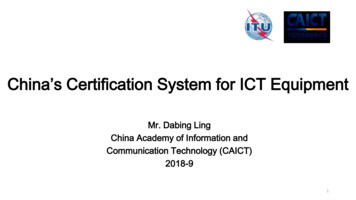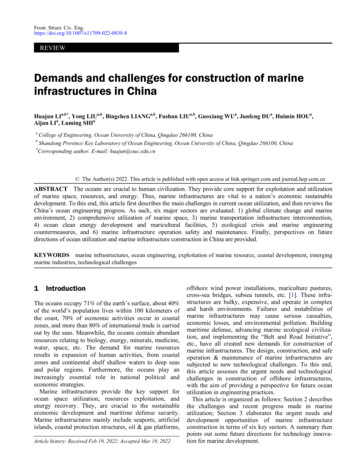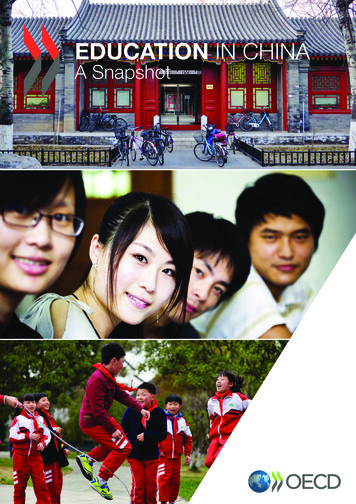
Transcription
China’s Certification System for ICT EquipmentMr. Dabing LingChina Academy of Information andCommunication Technology (CAICT)2018-91
Course Objectives1Introduce China’s certification system for ICTequipment2Provide reference for implementation of ITU C&Iproject2
Agenda1Overview of China’s ICT product regulation pattern2Introduction of product certification system3Effects of product certification system4TLC Product Certification3
Several ConceptsConformity assessment, also known as compliance assessment, is any activity todetermine, directly or indirectly, that a process, product, or service meets relevanttechnical standards and fulfills relevant requirements [1].Certification is defined as a third-party attestation related to products, processes,systems or persons.[2]Accreditation is defined as a third-party attestation related to a conformityassessment body conveying formal demonstration of its competence to carry outspecific conformity assessment tasks. [2][1] ISO/IEC Guide 2:2004 Standardization and related activities -- General vocabulary[2] ISO/IEC 17000:2004 Conformity assessment – Vocabulary and general principles4
Overview of ICT Product Regulation PatternsNetwork Access License hina CompulsoryCertification (CCC)RadioEquipmentChina Type Approval(CTA)Regulation PatternRegulation ScopeChina CompulsoryCertification (CCC)Telecommunications terminalequipment, Audio-video equipment,Information technology equipmentVoluntary ProductCertification(e.g. TLC, CQC)Cable, optical cable, power supply, airconditioner, storage battery,distributing frame, etc.Network AccessLicense (NAL)Telecommunications terminalequipment, wireless communicationequipment and equipment used innetwork interconnectionChina Type Approval(CTA)Radio EquipmentOthersChina RoHS; China EnvironmentalLabeling; Network security; GreenLabeling, etc.5
Focus of Different Regulation PatternsNetwork Access License (NAL)InfoSec andfunctionFrequencySpectrumRF receiverperformanceIWF betweencard ol andInterconnection ProtocolRFPerformanceChina TypeApprovalRF EmissionPerformanceAntennaPerformanceRE & CECS,RF Common ModeRS, Radiated ionCompatibilityMultipleSystemCompatibilityCall LinkInterconnectionNetworkAdaptabilityNAL TestFunctionPerformanceOther special untaryProductCertification6
Focus of Different Regulation PatternsNetwork Access License (NAL)InfoSec andfunctionFrequencySpectrumRF receiverperformanceIWF betweencard ol andInterconnection ProtocolRFPerformanceChina TypeApprovalRF ntennaPerformanceRE & CECS,RF Common ModeRS, Radiated ilityMultipleSystemCompatibilityCall LinkInterconnectionNetworkAdaptabilityNAL on7
China Certification SystemCategory and Field of CertificationNumber of Certification Bodiesin different areasChina CompulsoryCertification (CCC)Management SystemCertification (11)10325310Voluntary CertificationService Certification (22)165Voluntary ProductCertification (22)management systemvoluntary product certificationState-sponsored Certificationcompulsory product certificationsevice certification8
Agenda1Overview of China’s ICT product regulation pattern2Introduction of product certification system3Effects of product certification system4TLC Product Certification9
History of Product Certification System in ChinaDevelopment ofCCC CCIB MarkCCC MarkCCEE MarkUntil Apr. 30, 2003From May 1, 2002, CCC established2002Development ofVoluntary ProductCertificationVoluntary product certification system initially established2003Gradually improvedReasons for Implementing Product Certification System: Carry out commitment of accession of China to WTO; Improve market economy and trade, so as to adapt to market economy requirements; Regularize interior management, and optimize China’s product certification system; Similar to product certification systems in other countries, provide convenience formutual recognition;Regulations of theP.R. China onCertification andAccreditation,issued in 2003, 910
Development of Product Certification SystemNumber of product CBs in the past six years200165159150113108100831351191191069186Number of Product CBs2412956501190201220132014product certification body201520162017voluntary industrial product certification bodyCCCVoluntary certification for industrial productsVoluntary certification for agricultural products and foodDistribution of product certificates of different areasCCC53206866813Voluntary certification for industrialproducts36535036165Voluntary certification for agriculturalproducts and food96990445850Number of certificates200000400000Number of interprises600000Data Source:CNCA11
Regulatory Framework of Compulsory ProductCertification Institutional ReformGeneral Administration of Quality Plan of the StateCouncil , 2018,3Supervision, Inspection andQuarantineState Administration for Market RegulationAQSIQAssociationsattached to AQSIQDirect affiliates of AQSIQProvincial bureausOf Quality andTechnical SupervisionCIQs directlyunder AQSIQSAMRSupervisesSupervisesCertification and AccreditationAdministration of ChinaCNCAStandardization Administrationof ChinaSACAuthorizesChina National AccreditationService for d InspectionBodies and LabsDesignated Certification BodiesDCBs12
Regulatory Framework of Voluntary ProductCertification Institutional ReformGeneral Administration of Quality Plan of the StateCouncil , 2018,3Supervision, Inspection andQuarantineState Administration for Market RegulationSAMRAQSIQAssociationsattached to AQSIQSupervisesDirect affiliates of AQSIQProvincial bureausOf Quality andTechnical SupervisionCIQs directlyunder AQSIQSupervisesCertification and AccreditationAdministration of ChinaCNCAStandardization Administrationof ChinaSACAuthorizesChina National AccreditationService for nBodies and LabsSubcontractProduct Certification BodiesCBs13
Documentation SystemLaws andRegulationsThe laws are approved and announced by National People’s Congress; the administrativeregulations are approved and announced by the State Council; the rules are approved andannounced by the ministries and commissions under the State rational DocumentsNormative Documents are mainly issued by CNCA and CNAS.These documents cover nearly all the implementation procedures.National stipulations;national technical rules;national standards.Detailed rules for the implementation of CCC;Implementation rule of voluntary product certification;Program files;Instructions and operation guide;Regulations of CBs;etc.14
Documentation SystemGeneral: Standardization Law of P. R. ChinaLaws andRegulationsNormativeDocumentsIncluding the classification、nature and implementation methods of standards. Product Quality Law of P. R. ChinaCertification system, supervision system; responsibility and penalties of CBs, local organizations,producers and distributors. Law of P. R. China on Import and Export Commodity InspectionImport safety quality licensing system.TechnicalRequirements Regulations for The Implementation of the Standardization Law of P. R. China Regulations of the P.R. China on Certification and Accreditation etc.For CCC:OperationalDocuments Provisions on the Administration of Compulsory Product Certification, AQSIQ Decree (2009) No.117 Administrative Measures on Entry Verification of Civil Commodities subject to Import LicensingSystem, AQSIQ Decree (2001) No.6 etc.15
Documentation SystemCNCA:(mainly for CCC)Laws andRegulations Regulations for Compulsory Product Certification Mark, Notice No.1 (2001) of CNCANormativeDocuments Regulations on Designation of Certification Bodies, Inspection Bodies and Testing Laboratories forCompulsory Product Certification Catalogue description and definition of Compulsory Product Certification, Notice No.45 (2014) ofCNCA Implementation Rules for Compulsory Product CertificationTechnicalRequirements etc.CNAS: Accreditation criteria for CB/Inspection Bodies and Labs;OperationalDocuments Rules for the Accreditation of CB/Inspection Bodies and Labs; Guidelines for the Accreditation of CB/Inspection Bodies and Labs; Illustration for the Accreditation of CB/Inspection Bodies and Labs.16
Documentation SystemLaws andRegulationsFor CCC: Mandatory requirements set in national mandatory standards or national technical rules;NormativeDocumentsTechnicalRequirementsFor Voluntary Product Certification National standard; Industry standard; Technical specification for product certification; International standard;OperationalDocuments Group standard.17
Documentation SystemLaws andRegulationsGeneral: Program files set by CBs for product certification; Public document;NormativeDocumentsTechnicalRequirements Forms; Regulations of CBs; etc.For CCC: Detailed rules for the implementation of CCC based on normative documents issued by CNCA;For Voluntary Product Certification:OperationalDocuments Implementation rules issued by CBs; Certification scheme; etc.18
Supervision of CCC SystemAccessCondition Legitimate basis: Regulations on compulsory Product Certification Administration , etc. Designated certification body, designated testing body Unified catalogue , unified implementation rulesSpecialSupervision Frequency: once a year Object: designated certification body and designated testing body or labs Mode: office inspection, inspection of certified enterprise, spot check of certification file orinspection report, professional ability examination of approved personsMarket SpotCheck Frequency: multiple batches Object: certified enterprises of CCC Mode: State spot check supervision, local special law enforcement spot check for CCCcertification19
Supervision of Voluntary Certification In August 2015, General Office of State Council issued the notice about promotion of random spot check andstandardization of in-incident supervision and after-incident supervision. “Double random-one disclosure” regulatory mode: random selection of inspected objects, random selectionof law enforcement inspectors, and timely disclosure of supervision information.Local market supervision andmanagement departmentrandomly selects lawenforcement inspectors forspot checkCNCA will make the bodies withserious problems as keysupervision objects, andinvestigate and punish illegalorganizationsOnly for these two currentlyCNCA announces theinspection resultsQuality Management SystemEnergy Management SystemCNCA randomlyselects inspectedobjects, and makesthe check plan20
Key Factors for ficationProcessModeCertificationBasis21
Key Factors for ImplementationCatalogue description anddefinition (up to 2017.12)19 categories,132 items21 categories,164 itemsTotal 21 categories,164 items: Cover more than 10 sectors related to human life and health thatmay affect national economyProcessMode Telecommunications terminal equipment, Audio-video equipment,Information technology equipmente.g.CategoryCableDistributionPower SupplyBatteryAir conditionerSurge ProtectionWireless/Optical Module/RFID, etc.Number of Products78443086527Voluntary ProductCertificationBasisICT area:Compulsory ProductCertificationScopeThe first catalogue of productssubject to CCC (2001)22
Guidelines for Product Certification SchemesConformity assessment functions and activities within product certification schemesTypes of product certificationschemes1a 1b 2 3 4 5 6 NISelection, including planning and preparation activities, specification requirementsXXXXXXXXIIDetermination of characteristics, as applicable, by: testing, inspection, design appraisal,assessment of services or process, other determination activities, e.g. verificationXXXXXXXXIIIReviewXXXXXXXXIVDecision on XXXXVVIAttestation, licensinga) Issuing a certificate of conformity or other statement of conformityb) Granting the right to use certificates or other statements of conformityc) Issuing a certificate of conformity for a batch of productsd) Granting the right to use marks of conformity is based on surveillance or certification of a batchSurveillance, as applicable, by:a) Testing or inspection of samples from the open marketb) Testing inspection of samples from the factoryc) Assessment of the production, the delivery of the service or the operation of the processd) Management system audits combined with random tests or inspectionsX23
Key Factors for ImplementationFor Voluntary product certification, mainly (it depends on CBs): Type Testing Initial factory inspection Follow-up inspectionFor Compulsory Product Certification:ScopeProcess Based on implementation rule “classification management of producers,selection and determination of Certification Mode”ModeBasis Certification Elements mainly include: Type testing; Testing or inspection ofsamples taken from the factories; Assessment of manufacturers’ quality assurancesystem and consistency of products; Testing or inspection of samples taken fromthe market; Follow-up inspection on certified products; Design verification Selection of certification mode: Determine the Basic Certification Mode based onrisk grade、operability and economy; CBs implement classified management formanufacturing enterprises; CBs choose the suitable certification mode based onthe classification through adding one or more Certification Elements. e.g. Type Testing Follow-up inspection; or Initial factory inspection TypeTesting Follow-up inspection (Surveillance)24
Tips: Self Declaration of Conformity in CCC In June 2018, State Administration for Market Regulation and CNCA jointly issued the notice aboutadjustment and reformation of CCC certification catalogue and specific implementation rules. Some products removed from the CCC certification catalogue; Some products could adopt self declaration of conformity, such as Audio-video equipment, Informationtechnology equipment.Implementinternal qualitycontrolSign of selfdeclaration andInformationdeliveryType testingCreate technicaldocumentsUse of CCC MarkSelf-inspection offactory qualityassurancecapacityFollow upsupervision25
Key Factors for ImplementationCompulsory tandardsNationaltechnicalrulesModeVoluntary Groupstandard26
Key Factors for ImplementationProcessModeBasisApplication andAcceptanceSampling andTestingSampling andTestingInitial FactoryInspectionEvaluation andApprovalFollow-upInspectionCompulsory Product CertificationScopeApplication andAcceptanceBased on classificationof manufacturingenterprisesEvaluation andApprovalFollow-upInspection27
Key Factors for ImplementationApplication andAcceptanceProcessModeBasisInitial FactoryInspectionSampling andTestingEvaluation andApprovalVoluntary Product CertificationArrange Inspect TaskScopeFollow-upInspection28
Agenda1Overview of China’s ICT product regulation pattern2Introduction of product certification system3Effects of product certification system4TLC Product Certification29
Initiatives of Product Certification An internationally adopted measure to regulate economy and promotedevelopment A reliable method of organizations to enhance management level, guaranteeproduct quality and improve competitiveness A strategic choice of the nation to guarantee product safety, regulate market,guide consumers, protect environment, protect human life and health, and topromote international trade China implements Compulsory Product Certification in accordance withrelevant laws and regulations for the purpose of protection of state security,prevention of deceptive practices, and protection of human life or safety,animal or plant life or health, and the environment. China promotes voluntary certification to guide consumers, improveenterprises’ competitiveness, their products’ performance and their capabilityto maintain compliance.30
Effects and Advantages Certification results are widely recognized and adopted by various socialsectors Many laws and regulations have stipulations related to certification andaccreditation. The government agencies are adopting more and more certification and resultsin their efforts of transforming government functions. Products passing energy-saving and environmental protection certification aregiven priority in government procurement. More enterprises and consumers purchase goods according to conformityassessment results or quality, safety marks. Compulsory product certification could protect safety of human being as wellas national security.31
Effects and Advantages Product, service quality and management level have been enhanced throughcertification The average rate of product quality above standard in certified enterprises ismore than 92%, and in un-certified ones is less than 80%. More than 95% of surveyed enterprises believe that certification could improvethe customer satisfaction and enhance product quality, while nearly 90% thinkcertification could enhance the brand. To certain extent, certification have been promoting the national economicand social development. According to the statistics, certification and accreditation have contributed toChinese economic growth with certain pulling rate.32
Agenda1Overview of China’s ICT product regulation pattern2Introduction of product certification system3Effects of product certification system4TLC Product Certification33
Introduction of TLCTL Certification Center ( TLC for short ), is a department under CAICT, and it’s a professional certificationbody with product certification and management system certification ability. TLC mainly focus on qualitymanagement, promotion of ICT industry, and try to promote harmonious development of government,communication operators, manufactures, third-party inspection bodies and consumers.34
Four Development StagesPolicy oriented marketdemands technologydevelopmentFuturedirectionsIn 2004,29 telecommunicationbasic products under NAL convertto product certification.More than 200 products havecarried out product velopproduct certificationsystem, and set up pilotproject.In 2000,opportunitiesarising from policychanges.SystemdesignStart up35
Extension and AcceptanceReflect informationof products’ keycomponents andtest itemsFollow-up inspection:factory inspection testing;Or factory inspection enhanced designatedfield deCertificationBasisTestingReportShow diversity in unity, and seekunity in diversity.National standard;Industry standard;International standardTechnical specificationfor product certificationUnified testingreport format;Unified testingrequirements andmethods36
Extension and AcceptanceTLC product16certification scope11678835fiber and cablebatteryOptical moduledistributing frame/box44 Energy saving productspower supplywireless equipments 37
Extension and AcceptanceCertificate issuance of TLC voluntary product 0-2015Rapid growthperiodstationary160phaseValid Certificates (2017)1404000120300010080200060401000200fiber and cablepower supplyothersdistributing framebattery0valid certificatesproduct categories38
Extension and AcceptanceSet up communication industryplatform, jointly planning toimprove the quality ofcommunication products.Transfer trust, serve theindustry, and promote to risethe quality entry threshold.Support the government,promote the popularizationof standards, and promotethe conservation of socialresources.In 2012, e as part ofadministrativesupervision, withresults acceptedby competentdepartments.Cooperateresearch onsupplier qualitymanagement withcommunicationoperators.Training forcertificationtechnical leadersCarry out NALfrom ns at WuPromotionJiang, Shanghaimeeting of theand etc.new versionstandard formobile phonecharger.TLC certificatesregarded as onebasic condition ofmajor telecomoperators’bidding.Others accepted byhospitals, finance,transportation,radio & TV, andgovernment’sbidding.39
Future DirectionsReformDirections40
Abbreviation IndexCB: Certification BodyCCC: China Compulsory CertificationCCEE: China Commission for Conformity Certification of Electrical EquipmentCCIB: China Import and Export Commodity Inspection BureauCIQ: China Inspection and QuarantineCNCA: Certification and Accreditation Administration of the People’s Republic of ChinaCNAS: China National Accreditation Service for Conformity AssessmentCPC: Compulsory Product CertificationCS: Conducted SusceptibilityCTA: China Type ApprovalC&I: Conformity and InteroperabilityDCB: Designated Certification BodyEMC: Electro Magnetic CompatibilityESD: Electro-Static Discharge41
Abbreviation IndexICT: Information and Communication TechnologyIEC: International Electro-technical CommissionIECEE: The IEC System for Conformity Testing and Certification of Electrical EquipmentISO: International Organization for StandardsIWF: Inter-Working FunctionNAL: Network Access LicenseRE & CE: Radiated Emission & Conducted EmissionRF: Radio FrequencyRS: Radiated SusceptibilityRXD: Receive DataSAC: Standardization Administration of ChinaSAR: Specific Absorption RatioWTO: World Trade Organization42
Trainer informationTrainer: Mr. Dabing LingE-mail: lingdabing@caict.ac.cnDepartment: TL Certification Institute, CAICTAddress: No.28, Xinwai Street, Xicheng District, Beijing, P.R.China43
Thank You forYour Attention!中国信息通信研究院 http://www.caict.ac.cn44
Regularize interior management, and optimize China's product certification system; Similar to product certification systems in other countries, provide convenience for mutual recognition; Regulations of the P.R. China on Certification and Accreditation, issued in 2003, 9 Development of CCC Development of Voluntary Product Certification









